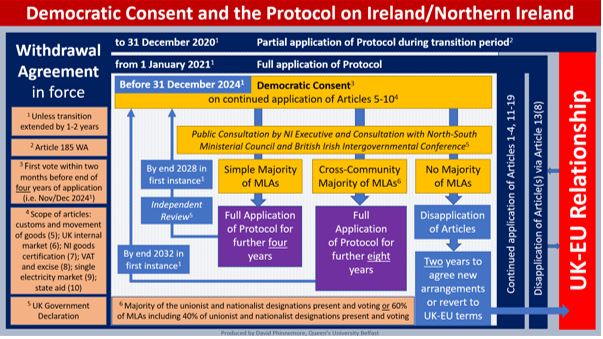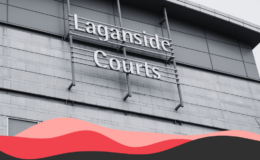- The NI Protocol means that Northern Ireland remains in the EU’s single market for goods – unlike England, Scotland and Wales. It was agreed by the UK and EU and came into force on 1 January 2021
- MLAs can only vote on certain parts of it. The Withdrawal Agreement states that the Assembly will periodically be asked to consent to trading arrangements in Articles 5-10 of the Protocol. The first of these consent votes is due to take place in December 2024.
- Even if the Protocol does not receive majority support at Stormont, it will not be removed. Instead, the UK and EU will have two years to agree new arrangements.
- So, when the Assembly votes the following may happen:
- No majority of MLAs means that there is two years to agree new arrangements
- A simple majority of MLAs means the Protocol will be in place until at least 2028
- A cross-community majority of MLAs means that the Protocol will be in place until at least 2032.
What is the Protocol?
During Brexit negotiations, the UK and the EU agreed to prioritise the Belfast/Good Friday Agreement. The focus was on keeping the land border between the Republic of Ireland (in the European Union) and Northern Ireland (in the UK) open and avoiding any new infrastructure along that border. However, after Brexit, a new arrangement was needed to enable an all-island economy functioning within the EU Single Market.
So, the EU and the UK negotiated the Protocol on Ireland and Northern Ireland (summary), which came into force on 1 January 2021.
According to Article 1(iii) of the Protocol, it sets out arrangements necessary to meet the shared objectives of the UK and the EU:
- to address the unique circumstances on the island of Ireland;
- to maintain the necessary conditions for continued North-South cooperation;
- to avoid a hard border [on the island of Ireland]; and
- to protect the 1998 Agreement in all its dimensions.
As a result of the Protocol, Northern Ireland has in effect remained in the EU’s single market for goods, while England, Scotland, and Wales are outside it. This allows goods to flow between Northern Ireland and Ireland (and the rest of the EU) without customs checks, tariffs or new paperwork. The EU’s rules on customs and regulation of products continue to apply to goods arriving in Northern Ireland from outside the EU (including from Great Britain).
What is the consent mechanism?
Under the terms of the Withdrawal Agreement (Article 18 of the Protocol), the Northern Ireland Assembly will be periodically asked to consent to the trading arrangements in Articles 5–10 of the Protocol for as long as they are in place. It will give MLAs an opportunity to vote on whether to remain in the arrangements or choose to exit from them. The first consent vote is due to take place by December 2024.

[Source: http://qpol.qub.ac.uk/democratic-consent-and-the-protocol-on-ireland-northern-ireland/]
How does the “democratic consent mechanism” work in practice?
This is the tricky part. As summarised by the House of Lords, Article 18 of the Protocol states that it provides a mechanism to:
“provide the opportunity for democratic consent in Northern Ireland to the continued application of Articles 5 to 10, namely the Articles on: customs and movement of goods; protection of the UK internal market; technical regulations etc.; VAT and excise; the Single Electricity Market; and State aid.”
The consent mechanism can currently be actioned by the Northern Ireland Assembly in one of two ways:
- Consent can be given by a simple majority vote in the Assembly, and the Protocol will continue to apply. Consent will need to be sought again within four years
- If the vote passes with cross community consent, then consent will only need to be sought again after eight years. A vote is classified as having cross community consent if either:
- a majority of total MLAs and a majority of both nationalist and unionists in attendance, vote in favour (known as “parallel consent”); or
- 60% of MLAs, including 40% of unionists and 40% of nationalists in attendance, vote in favour (known as a “weighted majority”).
If the consent is not given — it does not receive majority support — the Protocol will cease to apply after two years. In this case, the UK-EU Joint Committee established under the Withdrawal Agreement to oversee the Protocol will make recommendations to the UK and the EU on alternatives to Articles 5-10 of the Protocol for avoiding a hard border and protecting the Belfast/Good Friday Agreement. It is then up to the UK and EU to negotiate new arrangements that replace Articles 5-10 but which still meet the objectives of the Protocol, including avoiding a hard border on the island of Ireland.
So, could MLAs vote to revoke the Protocol, and in doing so remove it?
No. The consent mechanism only applies to Articles 5–10 of the Protocol. Even if a simple majority votes against giving consent in the December 2024 vote, the remainder of the Protocol still stands (including the non-diminution of rights and maintaining the conditions for North-South cooperation).




